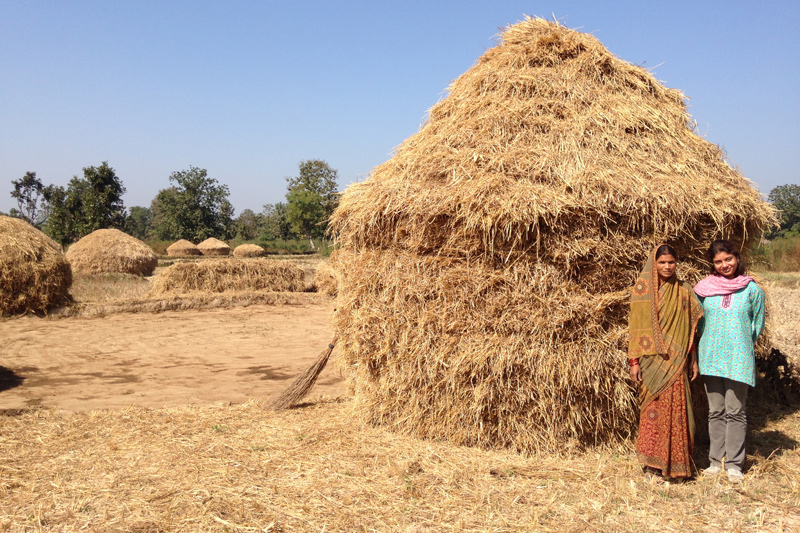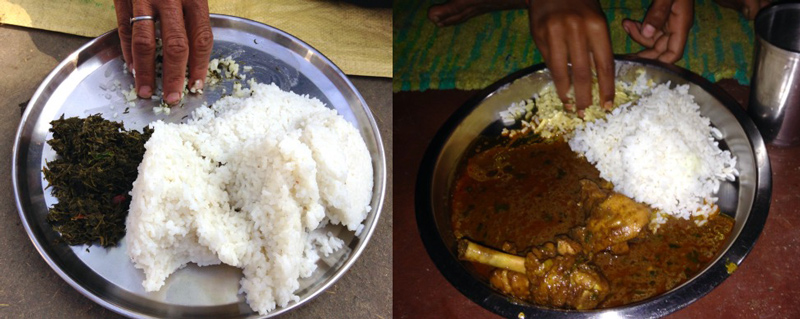


Helping India’s smallholder farmers
Photos courtesy of Pinki Mondal August 04, 2021
UD study suggests diversifying nutritional strategies in India to improve diets
To help smallholder farmers in India — farmers who own farms less than five acres in size — simply planting more crops is not enough, on its own, to provide year-round nutrition and the necessary food security.
Instead of simply employing the practice of multiple cropping — producing crops multiple times during the year and not just in one growing season — a new study led by the University of Delaware’s Pinki Mondal shows that smallholder farmers in India should instead look toward different nutrition strategies.
These strategies can be on the individual level, such as growing more diverse crops for personal consumption in their home gardens, or on a community-level, where individuals would work with their local communities and arrange to have farmers bring in different vegetables each week to the local markets.
The results of the study were published in Environmental Research Letters. Jessica Clark and Nicole Flowerhill, two UD graduates who worked on the project with Mondal during their time at UD, are coauthors on the paper.

Mondal, assistant professor in the Department of Geography and Spatial Sciences in UD’s College of Earth, Ocean and Environment and the Department of Plant and Soil Sciences in UD’s College of Agriculture and Natural Resources (CANR), said the project began when she travelled to central India to talk with semi-subsistence farmers to validate data from her remote sensing work. During that trip, she got to see the farmers’ diets firsthand.
“When I saw what they were eating, it struck me that these people are not just the producers, they are also consumers,” said Mondal. “In this particular landscape, whatever these semi-subsistence farmers grow in their small plots, they eat, and they sell a portion of it in the market.”
Mondal said that there is a school of thought that only focuses on the production pathway of food security — that because farmers are able to grow multiple crops during the year, they have food all-year round.
The unique landscape of central India allowed the researchers to test this theory because some farmers practice single cropping — harvesting only once a year — while others practice multiple cropping and harvest multiple times during the year.
“We could test whether having multiple cropping helped with year-round food security or even dietary diversity,” said Mondal.
Once she had the idea, Mondal developed a questionnaire and went back to India multiple times to talk with farmers from different villages to identify the different food items they were consuming.
The questionnaire also asked the households to identify their demographic and economic data, farming activities and livelihood choices — such as the primary fuel used for cooking, who cooks the food in the household and the number of times a member of the household visited a local market.
Working with members from the Foundation for Ecological Security (FES) in India, the researchers collected data from 600 unique households from 2016 through 2018. Two hundred households were interviewed for the three growing seasons — monsoon (the rainy season), winter, and summer.
The data collector on the FES team, Kusum Jhariya, also had the households fill out 24-hour and 30-day recall surveys, where the participants would recall what they ate over a 24-hour and a 30-day period. Based on those recalls, the researchers calculated the diversity in the diets of the respective households to investigate their food and nutritional security and dietary diversity.

All of the data was collected through hand-written surveys and interviews. Clark and Flowerhill looked through the scanned surveys and digitized the data entries.
Clark, who was supported on the project through a Center for Food Systems and Sustainability (CENFOODS) undergraduate research internship, said that it was beneficial to get a better understanding of all that goes into a research project.
Currently working with Quest Pharmaceutical Services, a contract research organization doing clinical research, Clark said that working with Mondal made her want to stay in the research field throughout her career.
“As I worked closely with Dr. Mondal throughout my internship, she taught me how to be a critical thinker and encouraged me to pay close attention to details while working on this project,” said Clark. “Working on this study also enhanced my organizational skills, which is a skill that will follow me throughout my career. I learned that research takes time, but if you are determined to complete a project, the end result will be fulfilling.”
Angelia Seyfferth, associate professor of biogeochemisty and plant-soil interactions in CANR, said that CENFOODS is happy to support talented students like Clark through their internship program.
“This opportunity allows students to engage in research with a faculty mentor on sustainability-related research by supporting their stipend of up to $6,000 over multiple semesters,” said Seyfferth. “Unlike the typical 10-week summer programs, this unique opportunity allows students to more fully engage with the research project for a longer period of time, which is often required to produce publication-quality work.”
Of the households surveyed, 43% experienced moderate to severe food insecurity in all seasons, and 81% of women in all seasons do not consume a minimally diverse diet.
Cereals, mainly rice, were the most important food item regardless of the season, and there was not much consumption of nutrient-rich foods such as fish, eggs and meat.
“We found out that multiple cropping does not by itself help with food security or dietary diversity,” said Mondal. “In this landscape, most of the houses don’t have refrigeration. So whatever they purchase from the market, they eat. Whatever they produce, they eat. They cannot store perishable food items, and most of these villages have a weekly produce market. So if you go visit these families on a market day, their food plate would look very different than what they eat the other times of the week.”
To help with the dietary diversity and food security, Mondal said that increasing production diversity in home gardens — such as planting leafy green vegetables — would be an effective tool to help with nutritional inadequacy, especially among women.
In addition to diversifying home gardens, a better local market structure could be put in place where farmers who are producing diverse crops, such as pulses (edible seeds), can sell those items at the local market.
Mondal stressed, however, that there is not just one simple solution to solving these complex dietary and nutritional security issues. It is also important to remember that these smallholder farmers produce much of the food that is consumed on a global scale.
“We need a holistic approach to understand the reality on the ground and how to better support these communities,” said Mondal. “When I travel there and talk to these people, it’s always a humbling experience for me. I remember one person, who offered me her last packet of pulses because she did not have anything else to offer me as food. She said she was saving it to plant next season, but said ‘I don’t have irrigation so I probably won’t be able to plant it, so why don’t you take it.’ These little things stay with you, and it changes you as a person.”
Contact Us
Have a UDaily story idea?
Contact us at ocm@udel.edu
Members of the press
Contact us at 302-831-NEWS or visit the Media Relations website

